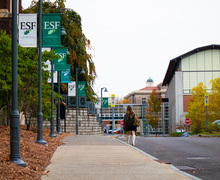SU professor assists in research, treatment of Onondaga Lake to restore water quality
Frankie Prijatel | Photo Editor
Now that the lake is usable, there are plans to make the Onondaga Lake a recreational destination, with the installation of biking and hiking trails in the works.
Syracuse’s Onondaga Lake is finally considered clean enough to be usable, thanks to a mass restoration project that has lasted three years.
The project was led by the engineering company Honeywell and was launched in response to multiple years of pollution and dumping in the lake. With the pollution came the disappearance of plant and wildlife around and in the lake. However, experts now say the lake has become safer and is now usable.
Before the cleanup began, it was one of the most polluted lakes in the country.
“It was really a tragedy to see this wonderful resource that was utilized by wildlife turned into a dumping ground,” said Chris Lajewski, center director of the Montezuma Audubon Center, a non-profit which works to conserve and restore natural ecosystems, focusing on birds, other wildlife, and their habitats.
In order to restore the quality of the water, professionals used a nitrate treatment to inhibit the dangerous levels of methylmercury culminating in the lake. This project was spearheaded by Charles Driscoll, an environmental engineering professor who teaches undergraduate and graduate classes at Syracuse University.
Driscoll measured the mercury levels in Onondaga Lake and used the information to convince Honeywell to add artificial nitrate to the water, limiting the formation of the mercury.
The project has been going on for three years, and will continue in the foreseeable future, Driscoll said. The nitrate addition costs around $200,000 a year, which is paltry in comparison to the $500 million that the entire cleanup has cost so far, Driscoll added.
“It’s important for the community because it’s a potential important economic driver for the community,” Driscoll said.
Parsons Corporation, alongside other firms, has also helped out with the lake cleanup. Additionally, hundreds of volunteers from the local community have showed up to support the project.
“It’s a great opportunity to engage the central New York community in this preservation work,” Lajewski said.
Audubon is planning more events in 2015 to encourage the community to continue to show support for the project, including an event on May 16, Lajewski said.
In the next few years, both Honeywell and Audubon plan to continue to monitor the bird population and watch for signs of local vegetation choking due to the influx of new species. Furthermore, Driscoll said they would continue to cap the lake in order to prevent another rise of mercury levels.
Now that the lake is usable, there are plans to make the Onondaga Lake a recreational destination, with the installation of biking and hiking trails in the works. There are also plans to build an amphitheater on one side of the lake near the state fairgrounds.
Overall, the lake cleanup is not only beneficial for the local community, it also serves as an example in environmental conservation for the country, Driscoll said.
“I think it’s an important problem nationally and globally because mercury is very difficult to clean up… This demonstrates that a cleanup can be done,” Driscoll said.
Published on April 7, 2015 at 10:55 pm
Contact Hanna: hrhorvat@syr.edu





